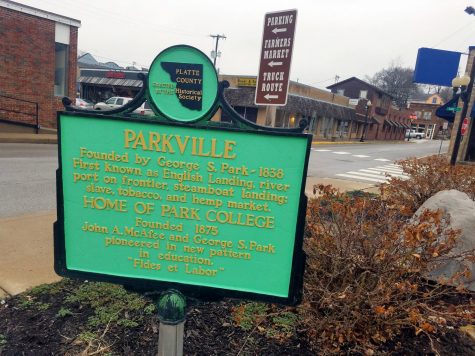English Landing sign raises questions about slavery
As an African-American male in this country, I take pride in my ethnicity, as should all.
When a public display challenges that pride, however, you bring a new problem to the table that is old as the word old: discrimination. The public display is a sign in Parkville representing the city’s founder George S. Park and founding of the city in 1836. This place was first known as English Landing Port or Frontier Steamboat Landing.
This sign is in the square at the corner of Highway 45 and Highway 9 in the heart of downtown Parkville. It sits in the front of Park University and it talks about slaves, tobacco, and the hemp market.
Parkville is home of Park College, founded by John A McAfee and George S. Park in 1875. They pioneered a new format of education. The sign was erected by the Platte County historical society.
For me, there are a lot of questions revolving around this controversy. I believe having something like this in the middle of a modern town can be diminishing to minorities that are American. Speaking with peers has provided one alternative perspective, however.
“Don’t sugar coat it,” says sophomore journalism major Kalie Strain. She said she believes the city itself is simply telling the truth from the get go. Others argue that it’s more of a “dark pride” that stands in this quiet town.

Truly understanding why the sign may be offensive to people like myself can be difficult, particularly here in Missouri, one of the last states to outlaw slavery.
I spoke to some Parkville residents who also work for the society founded by George S. Park. Both Caucasian males, their names and occupations are anonymous by request.
When asked about the sign and its casual reference to slaves alongside tobacco and hemp, their initial response was incredulous. Their foreheads wrinkled and eyes wide
ned.
“What exactly does it say,” asked one. I showed them the picture. Surprise and disgust washed over their faces and exuded through their body language, like a dormant shame rising to the surface.
Not every white male is responsible for the degradation of minorities, of course. However, the sign’s mundane acceptance allows this degradation to go on silently.
“It is kind of weird to have a signup like that in 2018,” said one of the men.
As time went by, drawing the touchy subject out of its comfortable silence into the open, an interesting thing happened. A sense of relief blew through the air, all of the past tension from before wafting away.
Putting the topic in its place, a rational discussion involving the facts of history and moving past disrespect and excuses allowed for an unseen unease to become a cathartic release. Perhaps putting the sign in its place might have the same effect. And perhaps that place isn’t on display in the middle of the town square.
Your donation will support the student journalists of Park University. Your contribution will allow us to cover our annual website hosting costs, freeing up other funds for equipment, printing and training.



Jerry McDaniel • May 1, 2018 at 11:18 am
Indeed, slavery was a very bad thing, without question. But I fail to understand Mr. McFaddens concern. Was hemp sold? Yes, Was tobacco sold? Yes. Were slaves sold? Yes. We must face our past for what it was. I don’t believe there needs to be any additional resources spent on clarifying the photograph. It is clearly stated that these events occurred.
As part Native American, I see no reference of the fur trading between the local indians and white people, I see no mention at all, that at one time the Native American roamed freely in these parts.
I think Mr. McFadden is somewhat sensitive to the subject. Which I understand and respect. In my opinion it is much more important that these events be taught via local education. And that we may never forget infamous past events, so that we may never repeat them.